The electric vehicle market continues to expand and innovate, with manufacturers pushing boundaries in technology, sustainability, and performance. In this in-depth comparison, we pit two exciting new entrants against each other: the Audi Q6 e-tron and the VW ID.7 Touring. Both vehicles represent their respective brands' commitment to electric mobility while catering to different segments of the market.
Audi Q6 e-tron vs VW ID.7 Touring – Differences & prices compared
Everyday use, family trips or long-distance drives – here’s where the differences show.
Discover whether Audi Q6 e-tron or VW ID.7 Touring fits your lifestyle better.
Design and Build Quality
The Audi Q6 e-tron boasts a robust SUV body type, featuring a sleek design that is synonymous with the Audi brand. Measuring 4771 mm in length, the Q6 e-tron has a wide stance with a height of 1685 mm. Its spacious 526-liter trunk capacity offers ample storage for everyday use.
On the other hand, the VW ID.7 Touring is a stylish wagon that measures 4961 mm in length, making it slightly longer yet lower than the Q6 e-tron, with a height of 1551 mm. The ID.7 Touring also excels in cargo space, providing up to 605 liters, ideal for family trips or a weekend getaway.
Powertrains and Performance
When it comes to powertrains, both vehicles offer a choice of rear-wheel drive and all-wheel drive configurations. The Audi Q6 e-tron impressively offers power outputs ranging from 292 HP to a sporty 516 HP, allowing for 0-100 km/h acceleration times as quick as 4.3 seconds for the high-performance variant. With battery capacities of 75.8 kWh and 94.9 kWh, the Q6 e-tron can achieve an electric range of up to 637 km, making it a strong choice for long-distance driving.
The VW ID.7 Touring, while slightly less powerful with a maximum output of 340 HP, impresses with its efficiency and agility. It accelerates from 0-100 km/h in just 5.5 seconds, showcasing its zippy performance. With battery capacities of 77 kWh and 86 kWh, the ID.7 Touring maximizes electric range, offering up to an impressive 690 km, making it one of the most efficient vehicles in its class.
Technology and Innovations
Both the Audi Q6 e-tron and the VW ID.7 Touring are equipped with the latest in automotive technology. The Q6 e-tron features Audi's advanced infotainment system, complete with a high-resolution display and seamless smartphone integration. The digital cockpit provides essential driving data at a glance, enhancing the driving experience significantly.
The ID.7 Touring embraces VW's Smart Experience technology, characterized by a user-friendly interface and voice control features. It also includes an advanced Driver Assistance package, which enhances safety and driving comfort. Both vehicles are committed to providing an eco-friendly drive, with zero CO2 emissions and strong efficiency ratings.
Charging and Sustainability
Charging capabilities are critical for any electric vehicle, and both the Q6 e-tron and ID.7 Touring excel in this area. The Audi Q6 e-tron can support high-speed charging, making it convenient for every kind of driver. Its battery management system ensures that energy efficiency is optimized. In contrast, the VW ID.7 Touring has exceptionally low energy consumption, boasting as low as 14 kWh/100 km, which resonates with environmentally-conscious consumers.
Conclusion: Which One to Choose?
The choice between the Audi Q6 e-tron and VW ID.7 Touring ultimately comes down to personal preference and priorities. For buyers seeking an SUV that combines luxury with performance, the Q6 e-tron stands out with its powerful engine options and sophisticated design elements. However, for those prioritizing range and efficiency, the ID.7 Touring offers an exceptional experience with its spacious cabin and impressive battery life.
Both vehicles represent a leap forward in sustainable transportation and demonstrate the capabilities of modern electric vehicles. Regardless of your choice, you are engaging with a product that will undoubtedly contribute positively to a greener future.
Here’s where it gets real: The technical differences in detail
Costs and Efficiency:
Looking at overall running costs, both models reveal some interesting differences in everyday economy.
VW ID.7 Touring has a somewhat advantage in terms of price – it starts at 47100 £, while the Audi Q6 e-tron costs 54400 £. That’s a price difference of around 7367 £.
In terms of energy consumption, the advantage goes to the VW ID.7 Touring: with 14 kWh per 100 km, it’s a bit more efficient than the Audi Q6 e-tron with 15.60 kWh. That’s a difference of about 1.60 kWh.
As for range, the VW ID.7 Touring performs hardly perceptible better – achieving up to 689 km, about 33 km more than the Audi Q6 e-tron.
Engine and Performance:
Power, torque and acceleration are the classic benchmarks for car enthusiasts – and here, some clear differences start to show.
When it comes to engine power, the Audi Q6 e-tron has a clearly perceptible edge – offering 490 HP compared to 340 HP. That’s roughly 150 HP more horsepower.
In acceleration from 0 to 100 km/h, the Audi Q6 e-tron is clearly perceptible quicker – completing the sprint in 4.40 s, while the VW ID.7 Touring takes 5.50 s. That’s about 1.10 s faster.
In terms of top speed, the Audi Q6 e-tron performs evident better – reaching 230 km/h, while the VW ID.7 Touring tops out at 180 km/h. The difference is around 50 km/h.
There’s also a difference in torque: Audi Q6 e-tron pulls distinct stronger with 855 Nm compared to 679 Nm. That’s about 176 Nm difference.
Space and Everyday Use:
Whether family car or daily driver – which one offers more room, flexibility and comfort?
Both vehicles offer seating for 5 people.
In curb weight, VW ID.7 Touring is slight lighter – 2191 kg compared to 2200 kg. The difference is around 9 kg.
In terms of boot space, the VW ID.7 Touring offers to a small extent more room – 605 L compared to 526 L. That’s a difference of about 79 L.
In maximum load capacity, the VW ID.7 Touring performs to a small extent better – up to 1714 L, which is about 185 L more than the Audi Q6 e-tron.
When it comes to payload, Audi Q6 e-tron slightly takes the win – 540 kg compared to 465 kg. That’s a difference of about 75 kg.
Who comes out on top?
Overall, the Audi Q6 e-tron shows itself to be is largely superior and secures the title of DriveDuel Champion.
It convinces with the more balanced overall package and proves to be the more versatile choice for everyday use.
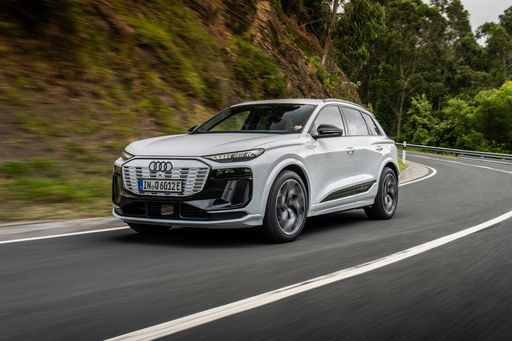 @ Audi AG
@ Audi AG
Audi Q6 e-tron
Audi Q6 e-tron
The Audi Q6 e-tron balances sleek, coupe-like styling with a roomy, upscale interior that feels modern without being showy. It delivers refined electric performance and smart tech that make daily driving effortless — the sort of EV that might make petrolheads grudgingly admit they fancy the future.
details @ Audi AG
@ Audi AG
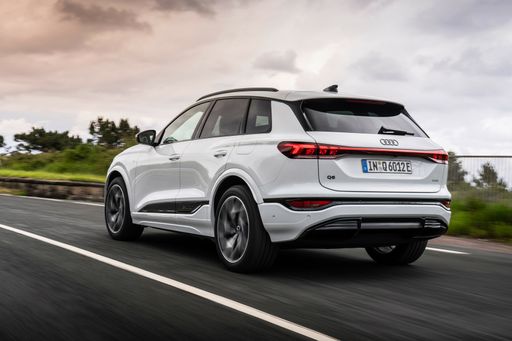 @ Audi AG
@ Audi AG
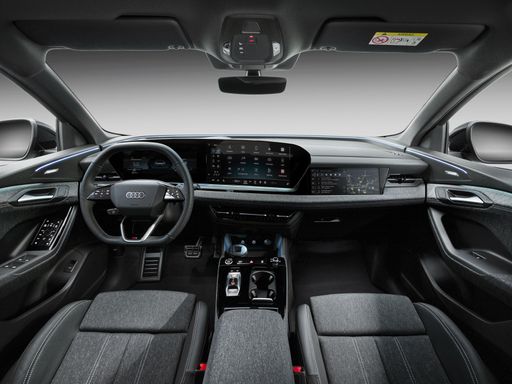 @ Audi AG
@ Audi AG
VW ID.7 Touring
The VW ID.7 Touring blends sleek, aerodynamic fastback looks with estate practicality, delivering an electric family car that looks grown-up and feels refined. Inside it's calm and spacious with clever storage and modern tech, swallowing suitcases and weekend plans with ease — a sensible, slightly flashy choice for buyers who want electric comfort without giving up practicality.
details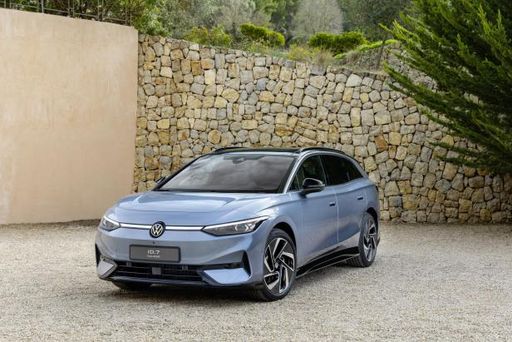 @ Volkswagen
@ Volkswagen
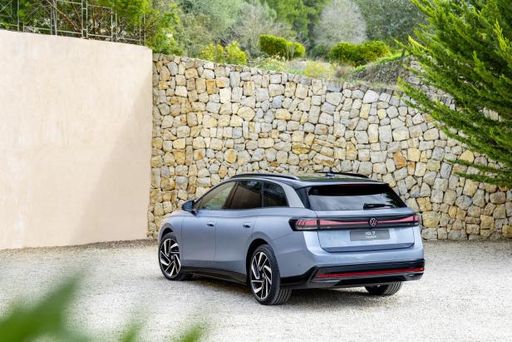 @ Volkswagen
@ Volkswagen
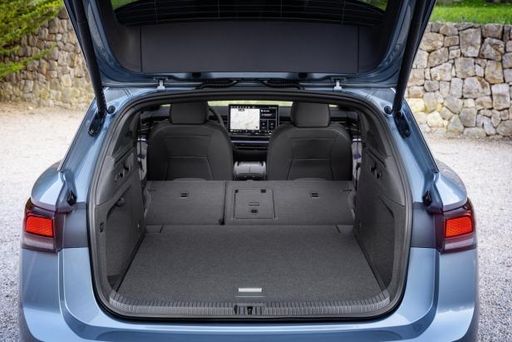 @ Volkswagen
@ Volkswagen
 @ Audi AG
@ Audi AG
|
 @ Volkswagen
@ Volkswagen
|
|
|
|
Costs and Consumption |
|
|---|---|
|
Price
54400 - 91900 £
|
Price
47100 - 54900 £
|
|
Consumption L/100km
-
|
Consumption L/100km
-
|
|
Consumption kWh/100km
15.6 - 18.9 kWh
|
Consumption kWh/100km
14 - 16.6 kWh
|
|
Electric Range
482 - 656 km
|
Electric Range
584 - 689 km
|
|
Battery Capacity
75.8 - 94.9 kWh
|
Battery Capacity
77 - 86 kWh
|
|
co2
0 g/km
|
co2
0 g/km
|
|
Fuel tank capacity
-
|
Fuel tank capacity
-
|
Dimensions and Body |
|
|---|---|
|
Body Type
SUV
|
Body Type
Estate
|
|
Seats
5
|
Seats
5
|
|
Doors
5
|
Doors
5
|
|
Curb weight
2200 - 2425 kg
|
Curb weight
2191 - 2336 kg
|
|
Trunk capacity
499 - 526 L
|
Trunk capacity
605 L
|
|
Length
4771 mm
|
Length
4961 mm
|
|
Width
1939 - 1965 mm
|
Width
1862 mm
|
|
Height
1665 - 1685 mm
|
Height
1549 - 1551 mm
|
|
Max trunk capacity
1361 - 1529 L
|
Max trunk capacity
1714 L
|
|
Payload
540 kg
|
Payload
459 - 465 kg
|
Engine and Performance |
|
|---|---|
|
Engine Type
Electric
|
Engine Type
Electric
|
|
Transmission
Automatic
|
Transmission
Automatic
|
|
Transmission Detail
Reduction Gearbox
|
Transmission Detail
Reduction Gearbox
|
|
Drive Type
Rear-Wheel Drive, All-Wheel Drive
|
Drive Type
Rear-Wheel Drive, All-Wheel Drive
|
|
Power HP
252 - 490 HP
|
Power HP
286 - 340 HP
|
|
Acceleration 0-100km/h
4.4 - 7.6 s
|
Acceleration 0-100km/h
5.5 - 6.7 s
|
|
Max Speed
210 - 230 km/h
|
Max Speed
180 km/h
|
|
Torque
450 - 855 Nm
|
Torque
545 - 679 Nm
|
|
Number of Cylinders
-
|
Number of Cylinders
-
|
|
Power kW
185 - 360 kW
|
Power kW
210 - 250 kW
|
|
Engine capacity
-
|
Engine capacity
-
|
General |
|
|---|---|
|
Model Year
2024 - 2025
|
Model Year
2024
|
|
CO2 Efficiency Class
A
|
CO2 Efficiency Class
A
|
|
Brand
Audi
|
Brand
VW
|
What drivetrain options does the Audi Q6 e-tron have?
Available configurations include Rear-Wheel Drive or All-Wheel Drive.
The prices and data displayed are estimates based on German list prices and may vary by country. This information is not legally binding.
